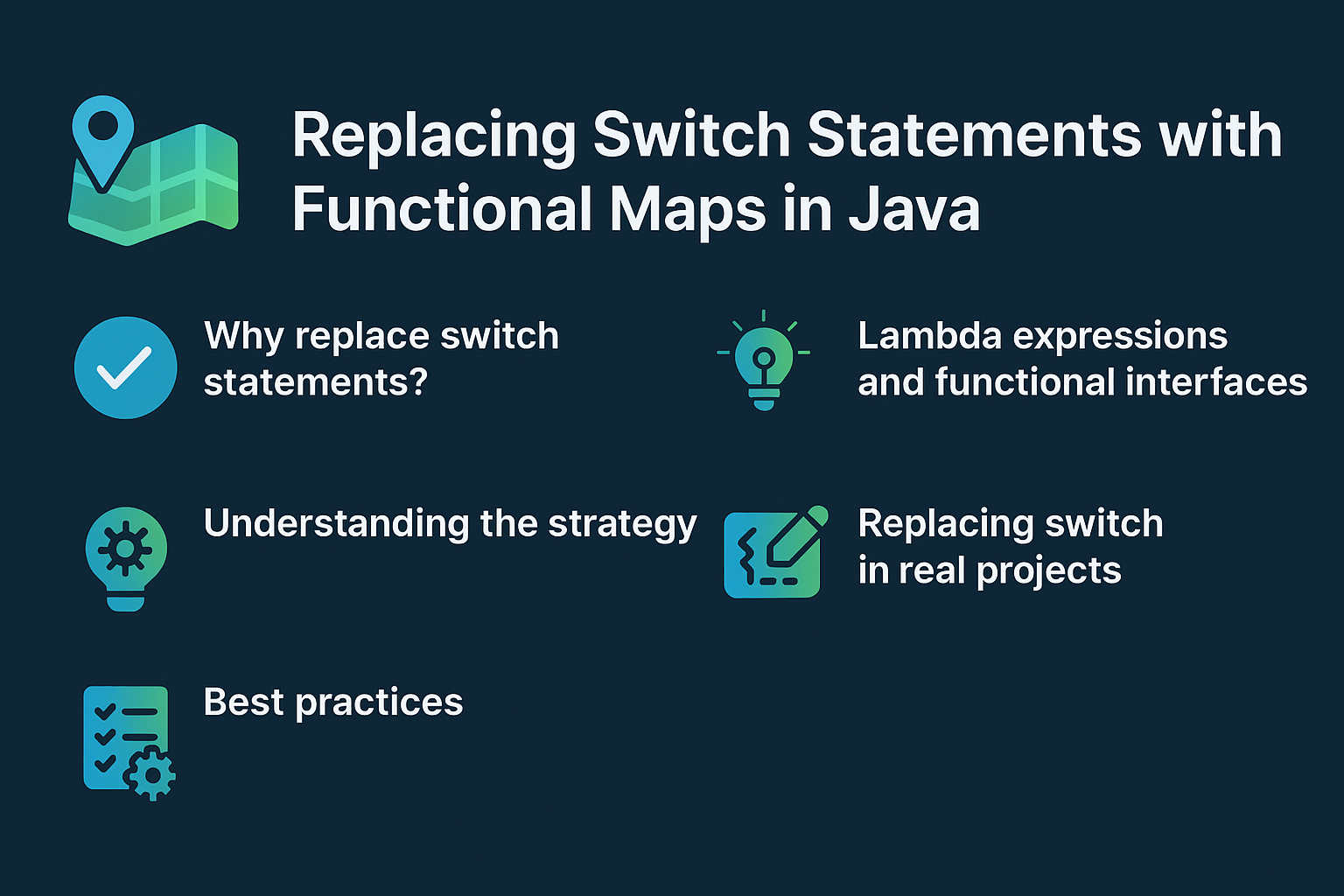Traditional switch statements are a staple of imperative programming in Java. While effective for handling conditional logic, they often become verbose, rigid, and hard to maintain—especially as complexity grows. Thankfully, with the advent of lambdas and the functional programming features introduced in Java 8 and beyond, developers can now replace cumbersome switch blocks with elegant and extensible functional maps.
This tutorial explores how to transition from switch statements to a functional style using java.util.function interfaces and Map-based dispatching.
🚀 Why Replace Switch Statements?
- Better readability: Fewer lines, declarative logic.
- Easier to extend: No need to modify long switch blocks for new cases.
- Testability: Functions can be unit-tested independently.
- Encapsulation: Behavior can be moved to isolated lambdas.
🧠 Understanding the Strategy
A functional map replaces a switch-case or if-else chain with a Map<Key, Function> or Map<Key, Runnable> structure that dispatches logic using lambdas. It's a variation of the Command Pattern but in a more functional and lightweight form.
🔧 Core Concepts Involved
✅ Lambda Expressions and Functional Interfaces
A lambda expression in Java is essentially a short block of code which takes in parameters and returns a value. It is a replacement for anonymous inner classes.
// Traditional
Runnable r1 = new Runnable() {
public void run() {
System.out.println("Hello");
}
};
// Lambda
Runnable r2 = () -> System.out.println("Hello");
Functional interfaces like Runnable, Consumer, Function, Supplier, and Predicate from the java.util.function package are key to functional maps.
🛠️ Implementing Functional Maps (Step-by-Step)
Example 1: Basic Command Dispatcher with Runnable
import java.util.HashMap;
import java.util.Map;
public class CommandMapExample {
public static void main(String[] args) {
Map<String, Runnable> commandMap = new HashMap<>();
commandMap.put("start", () -> System.out.println("Starting..."));
commandMap.put("stop", () -> System.out.println("Stopping..."));
commandMap.put("pause", () -> System.out.println("Pausing..."));
String input = "start"; // This could come from user input or API
commandMap.getOrDefault(input, () -> System.out.println("Invalid command")).run();
}
}
Example 2: Returning Values with Function
import java.util.Map;
import java.util.function.Function;
public class Calculator {
public static void main(String[] args) {
Map<String, Function<Integer[], Integer>> operations = Map.of(
"add", nums -> nums[0] + nums[1],
"subtract", nums -> nums[0] - nums[1],
"multiply", nums -> nums[0] * nums[1]
);
Integer result = operations
.getOrDefault("add", nums -> 0)
.apply(new Integer[]{5, 3});
System.out.println(result); // 8
}
}
🔄 Replacing Switch in Real Projects
Let’s look at how to use functional maps in a REST controller or service layer to cleanly map commands, event types, or even database operations to specific handlers.
Map<String, Consumer<Request>> handlerMap = new HashMap<>();
handlerMap.put("CREATE_USER", request -> createUser(request));
handlerMap.put("DELETE_USER", request -> deleteUser(request));
handlerMap.getOrDefault(request.getAction(), r -> {
throw new IllegalArgumentException("Unknown action");
}).accept(request);
📌 What's New in Java 8–21?
- Java 8: Lambdas, functional interfaces, Stream,
Optional,Map.computeIfAbsent(),forEach() - Java 9:
Map.of(),Optional.ifPresentOrElse() - Java 11:
varsupport in lambdas, string methods for functional use - Java 21: Virtual threads make lambda-based task delegation more scalable; structured concurrency pairs well with functional command maps
🧱 Real-World Analogy
Think of a functional map like a smart vending machine:
- The key is your selection code (like "C1" for a Coke).
- Behind that key is a lambda function (like
() -> dispense(Coke)).
No switch block is needed to decide what to do — just map the key to behavior and let it execute.
🧼 Best Practices
- Validate input before invoking
.get()on the map. - Use
getOrDefault()orcomputeIfAbsent()for safety. - Prefer immutability using
Map.of()orCollections.unmodifiableMap()for fixed behaviors. - Log missing or unsupported operations.
- Avoid mixing imperative switch blocks with functional maps.
❌ Anti-Patterns to Avoid
- Overloading the map with complex branching inside lambdas.
- Ignoring exception handling — wrap lambdas carefully.
- Not using fallback/default handlers.
- Forgetting to handle null inputs gracefully.
✅ Conclusion & Key Takeaways
- Functional maps help replace verbose switch statements with a cleaner, extensible, and testable alternative.
- Leverage built-in interfaces like
Runnable,Function,Consumer, andSupplier. - Use
Mapand lambdas for command routing, API operations, and event-driven logic. - This aligns perfectly with functional programming principles and modern Java best practices.
❓ FAQ
Q1: Can I use lambdas for exception handling?
Yes, but wrap logic in try-catch blocks inside the lambda body.
Q2: What’s the difference between Consumer and Function?Consumer<T> performs an action without returning a result. Function<T, R> transforms input and returns a result.
Q3: When should I use method references over lambdas?
Use method references when you’re simply calling an existing method. It improves readability.
Q4: Are lambdas garbage collected like normal objects?
Yes, lambdas are treated as objects and garbage collected accordingly.
Q5: How does effectively final affect lambda behavior?
Only effectively final variables can be accessed in lambdas, ensuring safety in closures.
Q6: Can functional maps fully replace switch statements?
Yes, in most cases. However, for simple enums or very short logic, switch can be fine.
Q7: Is performance better with functional maps?
It depends. For small logic, performance is similar. For extensibility and readability, functional maps win.
Q8: Are functional maps thread-safe?
Not inherently. Use ConcurrentHashMap for shared maps in concurrent environments.
Q9: Can I combine enums with functional maps?
Yes! Enums can be used as keys and methods as values.
Q10: How do functional maps fit into Spring?
Perfectly. You can inject maps of beans or lambdas based on qualifiers or keys.
